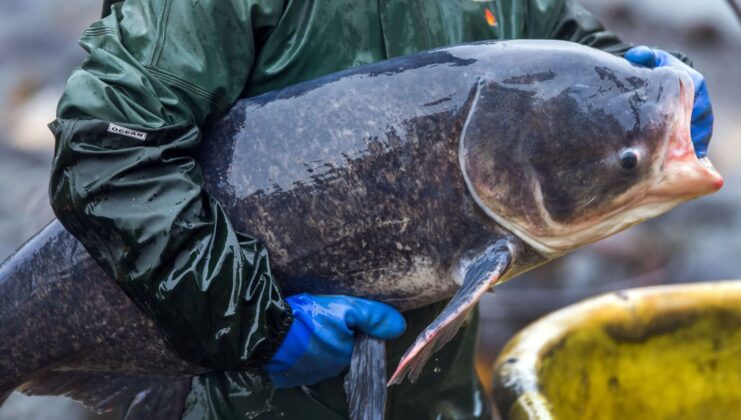Illinois might be known for its vast farmlands and bustling urban centers, but for anglers and fishing enthusiasts, this state has a wealth of watery treasures hiding beneath its serene lakes and winding rivers. If you’ve ever wondered about the giants lurking beneath the surface, you’re in for a treat. In this article, we’ll introduce you to the 10 biggest fish species found in Illinois, taking you on an aquatic journey of discovery.
1. Blue Catfish – The Titans of Freshwater
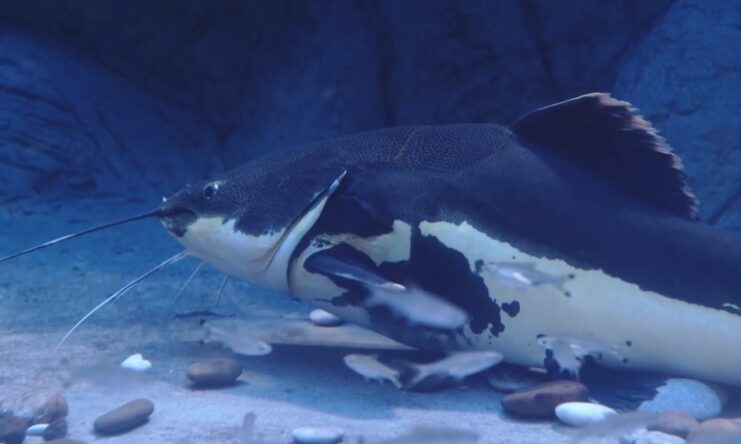
Physical Features & Habitat
The Blue Catfish is not just the biggest catfish species in Illinois; it’s the behemoth of freshwater fish in North America. With its silvery-blue body, forked tail, and sharp sense of smell, this fish dominates its surroundings.
- Size: Can reach up to 150 pounds.
- Habitat: Large rivers and deep channels.
Predominantly found in the Mississippi, Ohio, and Wabash rivers in Illinois, these fish are ambush predators, usually hunting at night. Their diet mainly consists of smaller fish, but they are known to eat almost anything.
Fishing for Blue Catfish
Despite their size, Blue Catfish can be a thrill for anglers. They are strong fighters and can give even the most seasoned fisherman a run for their money.
- Best time to fish: Late spring to early summer.
- Bait: Cut bait, especially shad or herring.
2. Flathead Catfish – The Silent Giants
Physical Features & Habitat
Another massive catfish species, the Flathead, stands apart with its flattened head and yellow-brown body. Their undersides are usually pale, making them easy to distinguish from their Blue counterparts.
- Size: Commonly around 25-40 pounds, but can reach over 100 pounds.
- Habitat: Slow-moving rivers and deep pools.
Found throughout many of Illinois’ water systems, Flatheads have a unique diet. Unlike other catfish, they mainly eat live prey, preferring fish like sunfish or shad.
Fishing Tips
For those hoping to snag one of these giants, patience is key. Flatheads are solitary creatures and can be somewhat elusive.
- Best time to fish: Warm summer nights.
- Bait: Live bait, such as small bluegill.
3. Muskellunge (Muskie) – The Ambush Experts
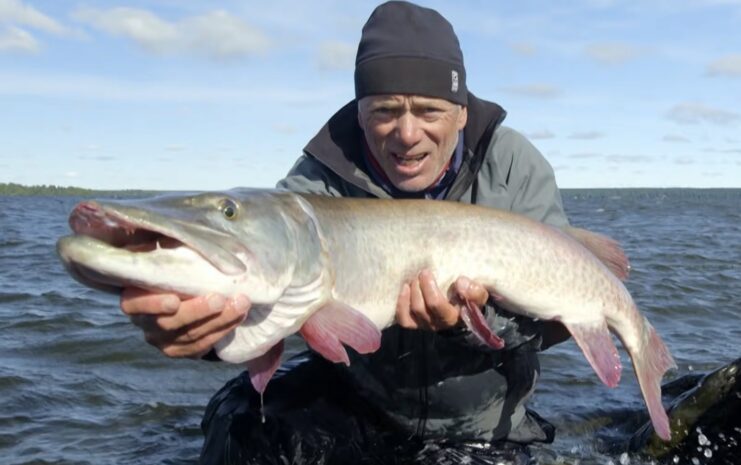
Physical Features & Habitat
A freshwater predator like no other, the Muskie is a long, slender fish with vertical stripes. They have a unique duckbill-shaped snout, which they use to their advantage when hunting.
- Size: Average around 30 pounds, but some can surpass 50 pounds.
- Habitat: Clear, vegetated lakes and large rivers.
Illinois offers several bodies of water where these fish thrive, most notably the Fox Chain O’Lakes.
Fishing Insights
Muskie fishing requires dedication. They are known as the “fish of ten thousand casts,” indicating the challenge in catching them.
- Best time to fish: Fall, during their feeding frenzy.
- Bait: Large spinners or live bait.
4. Northern Pike – The Water Wolves
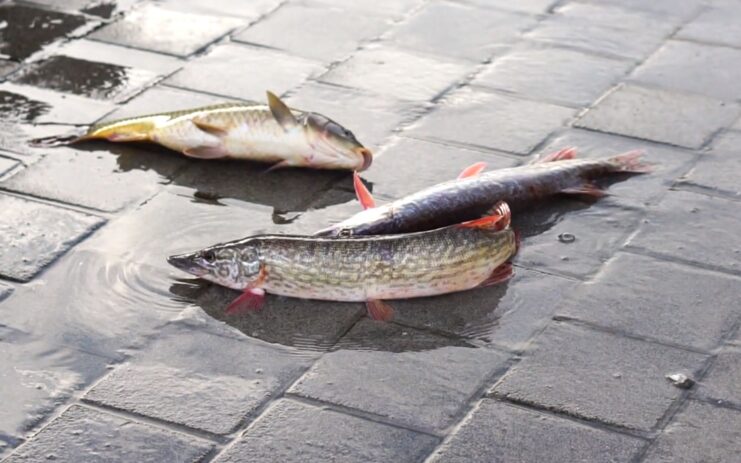
Physical Features & Habitat
Known for their sharp teeth and aggressive nature, Northern Pike have a torpedo-shaped body with light-colored spots against a darker backdrop.
- Size: Generally between 20-40 pounds.
- Habitat: Weedy, shallow waters.
These predators can be found in many of Illinois’ lakes and rivers, especially in the northern part of the state.
Fishing Strategies
Pike are aggressive and can often be caught throughout the day.
- Best time to fish: Early spring or late fall.
- Bait: Spinnerbaits or spoons.
5. Bighead Carp – The Invading Filter-Feeders
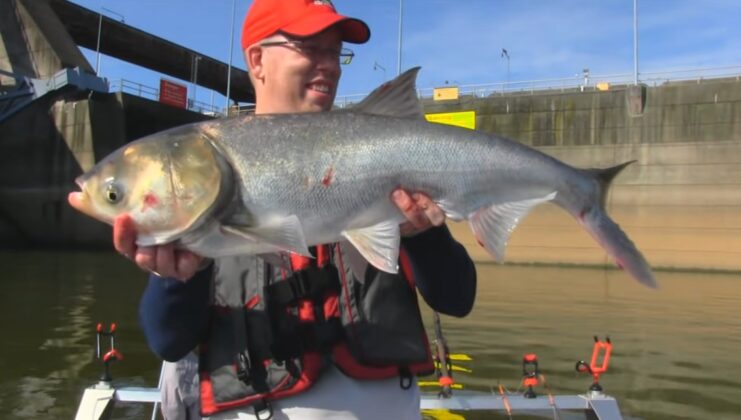
Physical Features & Habitat
Introduced to the U.S. to manage algae in fish ponds, these fish quickly spread to local waterways. They have a large head and a toothless mouth, ideal for filter-feeding.
- Size: 20-110 pounds.
- Habitat: Large rivers and connected lakes.
Found predominantly in the Mississippi and Illinois rivers, they feed by filtering plankton from the water.
Fishing Guidelines
Though not traditionally targeted by anglers, their massive size can be appealing.
- Best time to fish: Summer.
- Bait: They don’t bite on bait. Use nets or bow fishing.
6. Silver Carp – The Jumping Threat
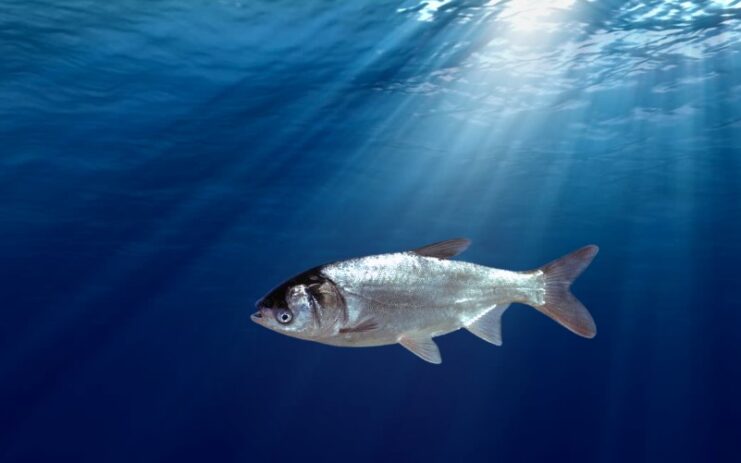
Physical Features & Habitat
Cousins to the Bighead Carp, Silver Carps are best known for their jumping ability. They can leap high when startled, posing a hazard for boaters.
- Size: Typically between 20-60 pounds.
- Habitat: Rivers, especially the Illinois and Mississippi.
These filter-feeders have a similar diet to the Bighead, consuming plankton.
Fishing Techniques
Like the Bighead, traditional fishing methods don’t always work. Bowfishing is a popular choice.
- Best time to fish: Warm days.
- Techniques: Bowfishing or using nets.
7. Alligator Gar – The Prehistoric Fighter
Physical Features & Habitat
With a snout resembling an alligator and a body that’s a testament to its ancient lineage, the Alligator Gar is a spectacle. It’s one of the largest freshwater fishes in North America.
- Size: Regularly between 100-200 pounds.
- Habitat: Backwaters, bayous, and large rivers.
Fishing Recommendations
Catch and release are often recommended due to their dwindling numbers.
- Best time to fish: Summer nights.
- Bait: Cut bait or live fish.
8. Grass Carp – The Vegetation Controllers
Physical Features & Habitat
Introduced to help control aquatic vegetation, Grass Carp are herbivorous and prefer freshwater lakes and ponds.
- Size: Usually 20-70 pounds.
- Habitat: Freshwater ponds and lakes with abundant vegetation.
Fishing Tips
Though not as popular among anglers, they can provide a fun catch.
- Best time to fish: Late spring and early summer.
- Bait: Vegetation or dough balls.
9. Buffalo Fish – The Native Giants
Physical Features & Habitat
These large, silver fish are native to Illinois and have been a staple for commercial fishermen for years.
- Size: Commonly between 20-50 pounds.
- Habitat: Large rivers and reservoirs.
Fishing Insights
Buffalo Fish are popular among bow fishermen due to their size and abundance.
- Best time to fish: Spring during their spawn.
- Bait: Worms or corn.
10. Channel Catfish – The Popular Night Hunter
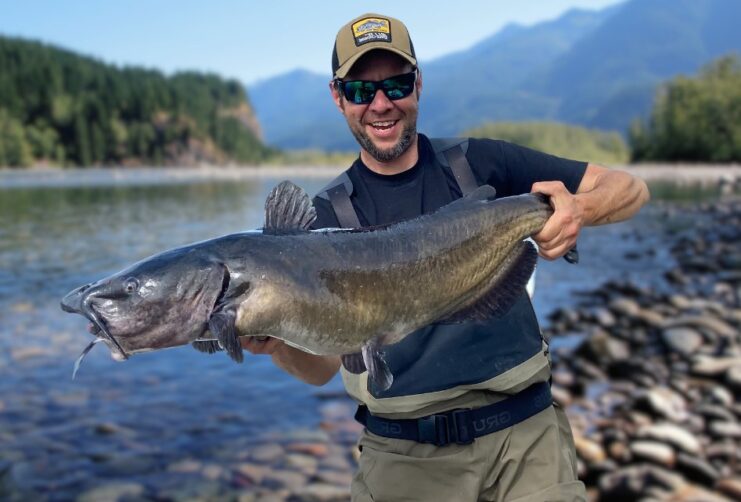
Physical Features & Habitat
Smaller than their Flathead and Blue cousins, Channel Catfish are easily recognizable by their slender bodies and deeply forked tails.
- Size: Typically 10-30 pounds.
- Habitat: Almost every freshwater system in Illinois.
Fishing Advice
Channel Catfish are one of the most sought-after species by Illinois anglers.
- Best time to fish: Warm summer nights.
- Bait: Stink bait, worms, or cut bait.
Tips and Techniques for Catching Bigger Fish
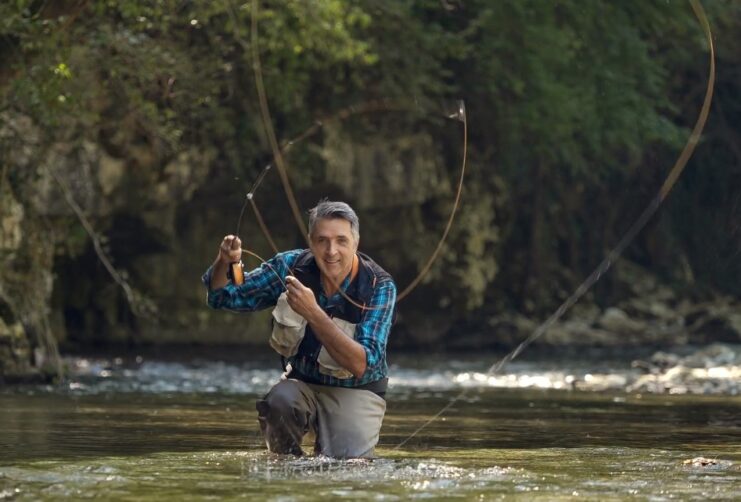
1. Understand Your Fish
Successful anglers often have a deep understanding of the fish species they’re targeting. The more you know about your favorite fish’s behavior, foraging habits, and seasonal habitats, the better angler you will be. For specific tips on various sport fish in Illinois, you can refer to the Sport Fish of Illinois page.
2. Preparation Before Fishing
- Map Study: Obtain a map or chart of your fishing destination. Determine the type of fishable habitats in the area and where they are located. Understanding fish habitat and how best to approach each type is crucial.
- Noise Control: Prevent unnecessary noise, especially when you’re in a boat. Fish can be sensitive to disturbances.
- Gear Check: Use the appropriate line and size of hooks for your target catch. Regularly check your line for kinks, nicks, or frays. Ensure your hooks are sharp.
- Vision: Wear polarized sunglasses to reduce glare and to better see fish and your lure in the water.
- Angler Diary: Keep a diary of your fishing experiences. Note down the equipment you used, the conditions, and the outcomes. This can be a valuable resource for future trips.
Most anglers find a good location and set up their camp as the most active hours for fishing is late at night and early in the morning.
3. Techniques and Tactics
- Setting the Hook: Ensure your fish is properly hooked before you start reeling. Keep the rod tip up and out of the water.
- Drag Use: Use your drag effectively and check its functionality regularly.
- Lure Mastery: Learn how to fish lures effectively. Techniques for fishing with jerkbaits, jigs, topwater lures, and others can be mastered with practice. There are many online resources, including videos and articles, to help improve your skills.
4. Know Your Fish Habitat
Fish often seek cover for protection or to ambush prey. Here are some habitats to consider:
- Docks: Both floating and permanent docks provide excellent fish habitat. The shade and structures, like algal growth on dock posts, attract baitfish, which in turn draw in larger fish.
- Rocks: Many lakes and rivers in Illinois have man-made rock piles along the shoreline. These rocky habitats provide hiding places for small fish, and bigger fish often patrol these areas looking for prey.
- Wood: Fallen branches, limbs, or trees in the water are prime fish habitats. The complexity of wood structures provides numerous hiding spots for fish. The Illinois Department of Natural Resources (IDNR) even sinks old Christmas trees into lakes to enhance habitats.
- Weeds: Aquatic vegetation serves multiple purposes, from providing food for microscopic invertebrates to offering protection for small fish. Larger fish are often attracted to areas with abundant aquatic vegetation.
Final Words
From the majestic Blue Catfish to the smaller yet equally fascinating Channel Catfish, Illinois boasts a rich and diverse aquatic ecosystem. Next time you’re by a river or a lake in this beautiful state, take a moment to appreciate the giants beneath the waters. Who knows, with the right bait and a bit of luck, you might just snag one of these behemoths!
Related Posts:
- Idaho’s Top 5 Biggest Fish Species - Aquatic Giants
- Unraveling the Topic Why Do Married Women Cheat: In…
- The Ultimate Guide to the Best Camping Spots in…
- Biggest Fish in Arizona: Top 10 Largest Fish Species…
- Biggest Fish in Arkansas: In Search of the Titans
- 8 Biggest Fish in California - Hooked on Legends

